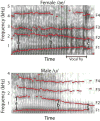Static measurements of vowel formant frequencies and bandwidths: A review
- PMID: 29891085
- PMCID: PMC6002811
- DOI: 10.1016/j.jcomdis.2018.05.004
Static measurements of vowel formant frequencies and bandwidths: A review
Abstract
Purpose: Data on vowel formants have been derived primarily from static measures representing an assumed steady state. This review summarizes data on formant frequencies and bandwidths for American English and also addresses (a) sources of variability (focusing on speech sample and time sampling point), and (b) methods of data reduction such as vowel area and dispersion.
Method: Searches were conducted with CINAHL, Google Scholar, MEDLINE/PubMed, SCOPUS, and other online sources including legacy articles and references. The primary search items were vowels, vowel space area, vowel dispersion, formants, formant frequency, and formant bandwidth.
Results: Data on formant frequencies and bandwidths are available for both sexes over the lifespan, but considerable variability in results across studies affects even features of the basic vowel quadrilateral. Origins of variability likely include differences in speech sample and time sampling point. The data reveal the emergence of sex differences by 4 years of age, maturational reductions in formant bandwidth, and decreased formant frequencies with advancing age in some persons. It appears that a combination of methods of data reduction provide for optimal data interpretation.
Conclusion: The lifespan database on vowel formants shows considerable variability within specific age-sex groups, pointing to the need for standardized procedures.
Copyright © 2018 Elsevier Inc. All rights reserved.
Figures






Similar articles
-
Vowel acoustic space development in children: a synthesis of acoustic and anatomic data.J Speech Lang Hear Res. 2007 Dec;50(6):1510-45. doi: 10.1044/1092-4388(2007/104). J Speech Lang Hear Res. 2007. PMID: 18055771 Free PMC article.
-
Frequency measurement of vowel formants produced by Brazilian children aged between 4 and 8 years.J Voice. 2015 May;29(3):292-8. doi: 10.1016/j.jvoice.2014.08.001. Epub 2014 Dec 12. J Voice. 2015. PMID: 25510161
-
Acoustic analysis of vowel formant frequencies in genetically-related and non-genetically related speakers with implications for forensic speaker comparison.PLoS One. 2021 Feb 18;16(2):e0246645. doi: 10.1371/journal.pone.0246645. eCollection 2021. PLoS One. 2021. PMID: 33600430 Free PMC article.
-
What Acoustic Studies Tell Us About Vowels in Developing and Disordered Speech.Am J Speech Lang Pathol. 2020 Aug 4;29(3):1749-1778. doi: 10.1044/2020_AJSLP-19-00178. Epub 2020 Jul 6. Am J Speech Lang Pathol. 2020. PMID: 32631070 Free PMC article. Review.
-
Static, dynamic, and relational properties in vowel perception.J Acoust Soc Am. 1989 May;85(5):2088-113. doi: 10.1121/1.397861. J Acoust Soc Am. 1989. PMID: 2659638 Review.
Cited by
-
Comparison of Praat and Computerized Speech Lab for formant analysis of five Japanese vowels in maxillectomy patients.Front Neurosci. 2023 Feb 1;17:1098197. doi: 10.3389/fnins.2023.1098197. eCollection 2023. Front Neurosci. 2023. PMID: 36816122 Free PMC article.
-
It Sounds like It Feels: Preliminary Exploration of an Aeroacoustic Diagnostic Protocol for Singers.J Clin Med. 2023 Aug 4;12(15):5130. doi: 10.3390/jcm12155130. J Clin Med. 2023. PMID: 37568532 Free PMC article.
-
Acoustic voice characteristics with and without wearing a facemask.Sci Rep. 2021 Mar 11;11(1):5651. doi: 10.1038/s41598-021-85130-8. Sci Rep. 2021. PMID: 33707509 Free PMC article.
-
Examining the voice of Israeli transgender women: Acoustic measures, voice femininity and voice-related quality-of-life.Int J Transgend Health. 2020 Aug 7;22(3):281-293. doi: 10.1080/26895269.2020.1798838. eCollection 2021. Int J Transgend Health. 2020. PMID: 34240071 Free PMC article.
-
Domestic dogs (Canis lupus familiaris) are sensitive to the correlation between pitch and timbre in human speech.Anim Cogn. 2022 Jun;25(3):545-554. doi: 10.1007/s10071-021-01567-4. Epub 2021 Oct 29. Anim Cogn. 2022. PMID: 34714438 Free PMC article.
References
-
- Abdelli-Beruh NB, Wolk L, Slavin D. Prevalence of vocal fry in young adult male American English speakers. Journal of Voice. 2014;28:185–190. - PubMed
-
- Alku P, Pohjalainen J, Vainio M, Laukkanen AM, Story BH. Formant frequency estimation of high-pitched vowels using weighted linear prediction. The Journal of the Acoustical Society of America. 2013;134:1295–1313. - PubMed
-
- Amir N, Amir O. Novel measures for vowel reduction. In: Trouvain J, editor. Proceedings of 16th International Congress of Phonetic Sciences. Saarbrücken: University des Saarlandes; 2007. pp. 849–852.
-
- Andrianopoulos MV, Darrow K, Chen J. Multimodal standardization of voice among four multicultural populations formant structures. Journal of Voice. 2001;15:61–77. - PubMed
-
- Angelocci AA, Kopp GA, Holbrook A. The vowel formants of deaf and normal-hearing eleven- to fourteen-year-old boys. Journal of Speech and Hearing Disorders. 1964;29:156–170. - PubMed
Publication types
MeSH terms
Grants and funding
LinkOut - more resources
Full Text Sources
Other Literature Sources

